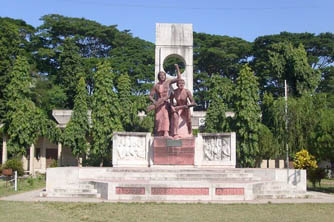RAJSHAHI, March 23, 2019 (BSS)-Apart from its pioneering achievement in
education and research, Rajshahi University (RU), the second largest varsity
of the country, had played a historic role in the struggle for an independent
Bangladesh.
During the independence war, RU teachers, officials and students carried
out a very tough fight to free the country from enemies. The Shabash
Bangladesh Chhattar, martyr archives, mass grave, and tombs of Dr.
Shamsuzzoha, Sukhrojjon Samaddar, Meer Abdul Qaiyum and Shaheed Habibur
Rahman and presence of existing freedom fighters make it glorious one.
After its establishment in 1953, one year into the Great Language
Movement, the RU has been vociferous in all national issues.
The students and teachers of RU have always been conscious to resist all
injustices. They never lag behind to play vital roles in different democratic
movements.
For instance, their movement for the cancellation of the report of disputed
education commission of 1962, mass uprising of 1969 for democracy and above
all active participation in the war of liberation in 1971 are remarkable in
the history of our country.
The RU’s contribution to independence war began from the massive movement
in 1969 that aimed at protesting the illegal and unlawful tyranny of the
Pakistani government.
Since then the students of this university became furious. On February 18,
1969 the students of the university brought out a protest procession. As the
police taking preparation to shoot at the procession, the proctor and
professor of the chemistry department Dr. Shamsuzzoha laid down his life to
save the students from the attacking police. Dr Zoha is the country’s first
martyred intellectual.
Besides, three other teachers of RU embraced martyrdom to free the country
from Pak army in liberation war in 1971. The martyred teachers are Prof. Meer
Abdul Qaiyum of psychology department, Prof. Shukhranjon Samaddar of language
department and Prof. Habibur Rahman of department of mathematics.
Earlier On 14 April in 1971, the Pakistani military entered the university
campus. They first stationed their headquarters at the Rajshahi University
guesthouse Juberi Bhavan. Later, they shifted headquarters to Dr. Zoha hall
which was used as a concentration camp until Pak retreat on December 18
night, 1971.
All the freedom loving and peace loving people were whisked away by the
army and their collaborators and kept into Zoha hall for tortured to death.
From the RU base, the Pakistani army led their destructive activities in
nearby areas of the city.
To pay tribute and recall contribution of these martyrs, the university
authorities set up several monuments and a museum on the campus.
In 1972 the authorities established Shaheed Smriti Sangrashala which is the
first museum of the country on the liberation war. After independence, on
April 23, 1972 a mass grave was discovered which was the largest in the
country.
Later in 2003, the university authorities built a mass graveyard monument
to pay respect to the martyrs on the east side of the campus.
Though Dr. Shamsuzzoha’s graveyard is well decorated and located in front
of the administrative building, Rajshahi University, many unsung heroes have
no memorials on the campus.



